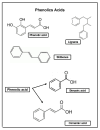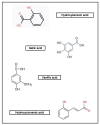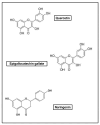Use of Medicinal Plants in the Process of Wound Healing: A Literature Review
- PMID: 38543089
- PMCID: PMC10975678
- DOI: 10.3390/ph17030303
Use of Medicinal Plants in the Process of Wound Healing: A Literature Review
Abstract
The literature on the use of medicinal plants in wound healing was comprehensively searched to obtain and assess the data. The data were procured via clinical studies that utilized medicinal plants and their compounds in vitro and in vivo for wound healing. This review collected data from electronic databases, including Google Scholar, PubMed, Science Direct, Web of Science, SciFinder, Thesis, and Scopus, using the search terms "natural products", "wound healing", and "natural compounds", along with the keywords "plants", "extracts", and "phytochemicals". Results from the last decade reveal a total of 62 families and 109 genera of medicinal plants, and their compounds have been studied experimentally both in vivo and in vitro and clinically found to effectively promote healing. This activity is related to the presence of secondary metabolites such as flavonoids, alkaloids, saponins, tannins, terpenoids, and phenolic compounds, which act at different stages through different mechanisms to exert anti-inflammatory, antimicrobial, and antioxidant effects, confirming that the use of medicinal plants could be an adequate alternative to current conventional practices for treating wounds.
Keywords: healing; medicinal plants; phytotherapy; plant extracts; secondary metabolites; treatments.
Conflict of interest statement
The authors declare no conflicts of interest.
Figures








Similar articles
-
Phytochemistry and Biological Activity of Medicinal Plants in Wound Healing: An Overview of Current Research.Molecules. 2022 Jun 1;27(11):3566. doi: 10.3390/molecules27113566. Molecules. 2022. PMID: 35684503 Free PMC article. Review.
-
Anadenanthera colubrina (Vell) Brenan: Ethnobotanical, phytochemical, pharmacological and toxicological aspects.J Ethnopharmacol. 2023 Jan 10;300:115745. doi: 10.1016/j.jep.2022.115745. Epub 2022 Sep 23. J Ethnopharmacol. 2023. PMID: 36162548 Review.
-
Investigation on wound healing effect of Mediterranean medicinal plants and some related phenolic compounds: A review.J Ethnopharmacol. 2022 Nov 15;298:115663. doi: 10.1016/j.jep.2022.115663. Epub 2022 Aug 28. J Ethnopharmacol. 2022. PMID: 36038091 Review.
-
Medicinal plants and their natural components as future drugs for the treatment of burn wounds: an integrative review.Arch Dermatol Res. 2014 Sep;306(7):601-17. doi: 10.1007/s00403-014-1474-6. Epub 2014 Jun 4. Arch Dermatol Res. 2014. PMID: 24895176 Review.
-
Review: African medicinal plants with wound healing properties.J Ethnopharmacol. 2016 Jan 11;177:85-100. doi: 10.1016/j.jep.2015.11.008. Epub 2015 Nov 5. J Ethnopharmacol. 2016. PMID: 26549271 Review.
Cited by
-
Comparative In Vitro and In Silico Analyses of Phytochemicals From Butea monosperma for Wound-Healing Potential in Human Cells.Cureus. 2024 Jun 10;16(6):e62078. doi: 10.7759/cureus.62078. eCollection 2024 Jun. Cureus. 2024. PMID: 38989336 Free PMC article.
-
In Vivo Assessment of Healing Potential of Ointments Containing Bee Products, Vegetal Extracts, and Polymers on Skin Lesions.Pharmaceuticals (Basel). 2025 Jan 9;18(1):65. doi: 10.3390/ph18010065. Pharmaceuticals (Basel). 2025. PMID: 39861128 Free PMC article.
-
Optimized Sambucus nigra L., Epilobium hirsutum L., and Lythrum salicaria L. Extracts: Biological Effects Supporting Their Potential in Wound Care.Antioxidants (Basel). 2025 Apr 27;14(5):521. doi: 10.3390/antiox14050521. Antioxidants (Basel). 2025. PMID: 40427403 Free PMC article.
-
Medicinal Plants for Skin Disorders: Phytochemistry and Pharmacological Insights.Molecules. 2025 Aug 6;30(15):3281. doi: 10.3390/molecules30153281. Molecules. 2025. PMID: 40807461 Free PMC article. Review.
-
Antimicrobial Smart Dressings for Combating Antibiotic Resistance in Wound Care.Pharmaceuticals (Basel). 2025 May 30;18(6):825. doi: 10.3390/ph18060825. Pharmaceuticals (Basel). 2025. PMID: 40573221 Free PMC article. Review.
References
-
- Strodtbeck F. Physiology of wound healing. Newborn Infant. Nurs. Rev. 2001;1:43–52. doi: 10.1053/nbin.2001.23176. - DOI
-
- Young A., McNaught C.E. The physiology of wound healing. Surgery. 2011;29:475–479. doi: 10.1016/j.mpsur.2011.06.011. - DOI
-
- Andrade M.G.L. Alterações do processo de cicatrização de queimaduras em indivíduos diabéticos. Rev. Bras. Queimaduras. 2013;12:42–48.
Publication types
LinkOut - more resources
Full Text Sources

